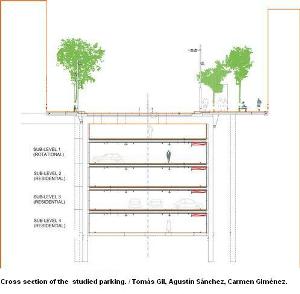Apr 2 2014
Researchers at the UPM have proposed better measures for greater efficiency at indoor parkings ventilation systems.

A research group at the School of Building Engineering of the Universidad Politécnica de Madrid (UPM) has conducted a study at an urban multiuse parking garage. The result was a new method that greatly reduces energy consumptions, CO2 emissions and ventilation systems cost, all compared with to the systems currently used.
The ventilation of an indoor parking garage consists of introducing acceptable air from outside and to filter the polluted air caused by car emissions, especially carbon monoxide (CO). The goal is to reduce all contaminants to reasonable healthy levels.
Thus, it is required to estimate the volume flow of the outside air needed to filter the CO under the limits permitted by law. The more accurate volume estimation, the better indoor air quality and efficiency. However, to estimate the volume flow is a complex task. Firstly, the current law that establishes the standards of ventilation systems design are generic solutions that no always correspond to reality because it is not based on data and, in some cases the law is obsolete. Secondly, the ventilation rate estimate can be influenced by some factors such as parking garage traffic (residential or rotational), its structure design, its location, etc. These factors are not taken into account by the current law.
This research was focused on accurate ventilation flow estimate that is necessary to not exceed permitted levels of CO concentration, and taking into account a new set of elements. Therefore, researchers studied in depth the factors that influenced the ventilation rate estimate in a parking garage located in Calle Serrano, Madrid.
Researchers also conducted an analysis of energy consumption and an environmental impact research. The results show that the current law leads to the oversizing of the indoor parking garage ventilation installations which causes greater energy consumption and the increase of CO2 emissions.
The conclusion shows that after studying the parking garage in Calle Serrano, the result is up to 24% less energy consumption and CO2 emissions. All this translates in 19% less in ventilation cost and a 6% total annual savings.
GIL-LÓPEZ, T; SÁNCHEZ-SÁNCHEZ, A; GIMÉNEZ-MOLINA, C. “Energy, environmental and economic analysis of the ventilation system of enclosed parking garages: Discrepancies with the current regulations”. Applied Energy 113: 622-630. DOI: 10.1016/j.apenergy.2013.08.012. January 2014.